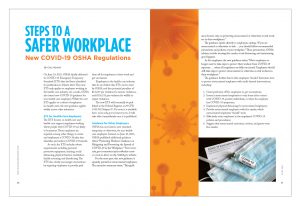Steps to a Safer Workplace
New COVID-19 OSHA Regulations
On June 10, 2021, OSHA finally delivered its COVID-19 Emergency Temporary Standard (ETS) that had been scheduled for publication in March 2021. That new ETS only applies to employers working in the health-care industry. As a result, OSHA also issued new COVID-19 guidance for non-health-care employers. While the new ETS applies to a subset of employers (in health care), the new guidance applies widely across other industries.
ETS for Health-Care Employers
The ETS focuses on health care and health-care support employers working where people with COVID-19 are likely to be present. Those employers are required, among other things, to create and implement a COVID-19 plan that identifies and reduces COVID-19 hazards.
As such, the ETS includes robust requirements including personal protective equipment, training, social distancing, physical barriers, ventilation, health screening, and disinfecting. The ETS also clearly encourages vaccinations by requiring employers to provide paid
time off for employees to leave work and get vaccinated.
Employers in the health-care industry that do not follow this ETS can be cited by OSHA and face potential penalties of $13,653 per violation for serious violations, and $136,532 per violation for willful or repeat violations.
The new ETS will eventually be published in the Federal Register at 29 CFR 1910.502 Subpart U. For now, it is available here: www.osha.gov/coronavirus/ets. It will take effect immediately once it is published.
Guidance for Other Employers
OSHA has not issued a new standard, temporary or otherwise, for non-health-care employers. Instead, on June 10, 2021, OSHA published additional guidance
titled, “Protecting Workers: Guidance on Mitigating and Preventing the Spread of COVID-19 in the Workplace.” Visit www.osha.gov/coronavirus/safework#what-workers-need-to-know on the OSHA.gov website.
For the most part, this new guidance is squarely pointed at unvaccinated employees. The executive summary states, “This guidance focuses only on protecting unvaccinated or otherwise at-risk workers in their workplaces.”
The guidance speaks directly to employees, stating, “If you are unvaccinated or otherwise at-risk . . . you should follow recommended precautions and policies at your workplace.” Those precautions, OSHA advises, include wearing face masks, social distancing, and maintaining good hygiene.
As for employers, the new guidance states, “Most employers no longer need to take steps to protect their workers from COVID-19 exposure . . . where all employees are fully vaccinated. Employers should still take steps to protect unvaccinated or otherwise at-risk workers in their workplaces.”
The guidance further directs that employers “should” determine how to protect unvaccinated employees with multi-layered interventions, including:
- Grant paid time off for employees to get vaccinations;
- Instruct unvaccinated employees to stay home after contact with COVID-19 positive individuals, or when the employee has COVID-19 symptoms;
- Implement physical distancing for unvaccinated employees;
- Provide unvaccinated employees with face masks, which unvaccinated employees “should” wear;
- Effectively train employees in the employer’s COVID-19 policies and procedures;
- Suggest that unvaccinated customers, visitors, and guests wear face masks;
- Maintain ventilation systems;
- Routinely clean and disinfect the workplace; and
- Record and report COVID-19 infections and deaths as required under 29 CFR 1904.
Higher-Risk Workplaces with Mixed Vaccination-Status Workers
The guidance provides additional “best practices” for employers in environments where there is a higher risk of COVID-19 infections—such as manufacturing, meat and poultry processing, high-volume retail and grocery, and seafood processing—where unvaccinated employees will likely have close contacts with other unvaccinated people.
For these employers, the best practices include:
- Stagger employee break times, and arrival and departure times;
- Post visual cues like floor markings as reminders and guides for physical distancing;
- Provide electronic payment options and move customer contact farther away from
unvaccinated employees; - Reschedule inventory stocking to off-peak hours for unvaccinated employees;
- Limit numbers of unvaccinated employees in employer-provided transportation; and
- “Make sure all unvaccinated” employees are wearing face masks.
Employee Vaccination Status
According to the Equal Employment Opportunity Commission, employers may inquire about employee vaccination status, provided that such information is kept confidential. However, the new OSHA guidance does not require employers to make such determinations. The guidance seems to assume that employers have that information.
Conclusions
The guidance references some mandatory OSHA standards but relies heavily on advisory and informational recommendations. “This guidance is not a standard or regulation,” OSHA concedes, “and it creates no new legal obligations. It contains recommendations as well as descriptions of existing mandatory OSHA standards.”
Despite the reliance on recommendations, employers should not discount the guidance as merely optional. OSHA may seek to enforce this guidance under the General Duty Clause.
In fact, the guidance states that “the recommendations . . . are intended to assist employers in providing a safe and healthful workplace free from recognized hazards that are likely to cause death or serious physical harm.” That language comes straight from OSHA’s General Duty Clause and signals OSHA’s intent to rely on it to enforce this guidance.
Should OSHA go that route, an employer can assert defenses to a General Duty Clause citation, such as the feasibility of implementing the guidance. Cited employers could also argue that OSHA violated the prohibition against using the General Duty Clause as a substitute for rulemaking. The fact that OSHA has issued the ETS for health-care employers suggests that it could have included this guidance within a standard, and therefore should not fall back on the General Duty Clause as a substitute.

